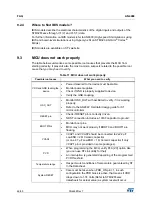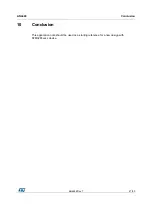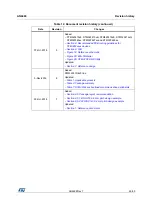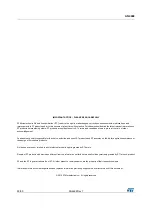
Recommended PCB routing guidelines for STM32F4xxxx devices
AN4488
40/50
AN4488 Rev 7
FLASH memories. The QUAD SPI interface is a serial data bus interface, that consists of a
clock (SCLK), a chip select signal (nCS) and 4 data lines (IO[0:3]).
Interface signal layout guidelines
•
Reference the plane using GND or PWR (if PWR, add 10nf stitching cap between PWR
and GND
•
Trace the impedance: 50
Ω
± 10%
•
The maximum trace length should be below 120mm. If the signal trace exceeds this
trace-length/speed criterion, then a termination should be used
•
Avoid using multiple signal layers for the data signal routing.
•
Route the clock signal at least 3x of the trace away from other signals. Use as less vias
as possible to avoid the impedance change and reflection. Avoid using a serpentine
routing.
•
Match the trace lengths for the data group within ± 10 mm of each other to diminish
skew. Serpentine traces (back and forth traces in an “S” pattern to increase trace
length) can be used to match the lengths.
Avoid using a serpentine routing for the clock signal and as less via(s) as possible for the
whole path. a via alter the impedance and add a reflection to the signal.
8.4.4
Embedded trace macrocell (ETM)
Interface connectivity
The ETM enables the reconstruction of the program execution. The data are traced using
the data watchpoint and trace (DWT) component or the instruction trace macrocell (ITM)
whereas instructions are traced using the embedded trace macrocell (ETM). The ETM
interface is synchronous with the data bus of 4 lines D [0:3] and the clock signal CLK.
Interface signals layout guidelines
•
Reference the plane using GND or PWR (if PWR, add 10nf stitching cap between PWR
and GND
•
Trace the impedance: 50
Ω
± 10%
•
All the data trace should be as short as possible (<=25 mm),
•
Trace the lines which should run on the same layer with a solid ground plane
underneath it without a via.
•
Trace the clock which should have only point-to-point connection. Any stubs should be
avoided.
•
It is strongly recommended also for other (data) lines to be point-to-point only. If any
stubs are needed, they should be as short as possible. If longer are required, there
should be a possibility to optionally disconnect them (e .g. by jumpers).











































